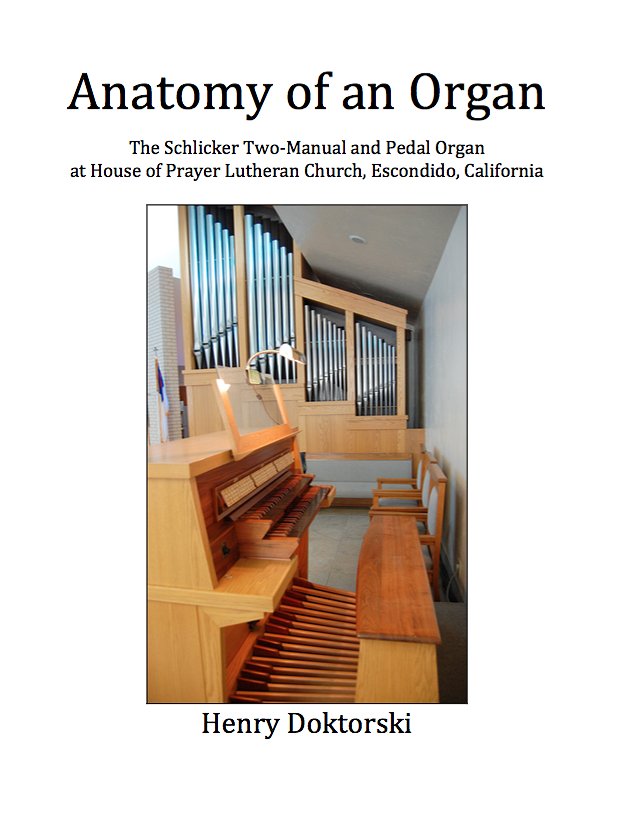Review of Henry’s Book/CD: Anatomy of an Organ
Samantha Gross

Anatomy of an Organ: The Schlicker Two-Manual and Pedal Organ at House of Prayer Lutheran Church, Escondido, California, by Henry Doktorski. 43 pages. 8.5 x 11 inches. Soft cover. Saddle-stitch binding. 37 photos, 36 in color. Includes a 31-minute, 15-track compact disc. Published by House of Prayer Lutheran Church, Escondido, California.
Review by Samantha Gross
Introduction
Henry Doktorski’s Anatomy of an Organ opens with a Mozart quote—“To my eyes and ears the organ will ever be the King of Instruments”—which is a power move and should be respected. I learned a lot of things from Henry’s book, including a delightful reminder of how good he is at his job. I guess there was stuff about the organ’s history too, so I can write about that.
First of all, our organ is expensive. Like, beyond my comprehension of money’s worth expensive, which isn’t saying much, because having two physical dollars at a time is a great day for me, but still. I’m talking almost just a chunk of it would get me out of all my student loan debt expensive.
Secondly, there were a bunch of cool ladies involved, mostly in running the committee and, oh yeah, providing a huge spelunking chunk of the money. Powerful women at work, yeah boy.
Thirdly, Henry is bitchin at his job, whatever it entails. Writer, photographer, musician, historian, all around cool dude. Noice.
Fourth, the technical stuff was all kind of confusing, but also like an Organs For Dummies books, so props to Henry for recognizing his audience knows Literally Nothing about how organs work.
Finally, the book is cool you should buy it. The end. Thanks. My mom [Carol Gross, the Director of Music at House of Prayer Lutheran Church] asked me to use my fancy English degree to write this
Review
Henry Doktorski’s Anatomy of an Organ includes everything you might ever want to know about House of Prayer’s organ. And while we lucky congregation members get to hear the organ every Sunday, how often do we really listen? Henry’s book kicks off with a history of the organ, starting with the idea for installation and highlighting the generosity of the congregation members. Henry’s historical account of the organ provides interesting insight into the creation of what has become such an important fixture in our church. House of Prayer simply wouldn’t be what it is today without our beautiful Schlicker two-manual and pedal organ.
Henry talks at length about the architecture and structure of the organ, which reads like a boastful compliment to the instrument and how House of Prayer has benefited from it. And while a lot of the technical language was lost on me, I could appreciate the time and effort that Henry devoted to showcasing our organ is such a flattering light. There’s a lot more to it than what we see (and hear) every Sunday, and it was like getting to peek below the hood of a familiar car to find that it’s engine is pure gold. Henry does a great job explaining everything, though I’m hoping he won’t quiz me on what all the mechanical parts are called. I’ll leave that mastery to him (and anyone else who wants to dig into the wonders of our pedal organ).
Henry steps momentarily out of his role as writer, musician, and historian, to become a photographer. He includes pictures of the organ, most of which show the industrial grace and majesty that both the interior and exterior of the organ display. The pictures provide an even better image (pun intended) of all the bells and whistles (literally) our organ includes, ranging from the foot pedal details to the ebony keys to the towering metal pipes and the tiny bells that make our organ so complex and charming.
The compilation is not only a showcase of our organ, but of our organist, who must appreciate both the church and the instrument an enormous amount to create something as researched as this. Henry’s book comes with a CD featuring a variety of pieces played on the organ (by Henry himself!). You can actually hear all the bits and pieces you read about, and that adds to the dimensions of both Henry’s work and the organ itself.
Henry’s book takes us through the ins and outs of the organ, and when I walk into church next Sunday after reading it, I hope I’ll get to see the organ in a new light. And after ten years of hearing it play, I hope this time I’ll really listen.
Samantha Gross earned a Bachelor of Arts degree in English with a Minor in Creative Writing from Concordia University in Irvine, California, where she graduated Magna Cum Laude. Coincidentally, she happens to be the daughter of Carol Gross, the Director of Music at House of Prayer Lutheran Church in Escondido, California.
This review was originally published in the House of Prayer Tidings, the monthly journal of House of Prayer Lutheran Church (February 2018).

Purchase Anatomy of an Organ Henry Doktorski’s 43-page book and 15-track CD about the history and specifications of the 1989 two-manual and pedal Schlicker organ at House of Prayer Lutheran Church in Escondido, California (including over 32 color photographs), can be purchased directly from the author. Send a check or money order for $19.99 (includes shipping to anywhere in the United States). Send email to the author inquiring about address. Credit card payments must go through PayPal. Send PayPal payment to the author at the e-mail address listed below. Canadian and overseas customers can pay with Western Union and must inquire directly from the author regarding shipping prices.
Back to Anatomy of an Organ Review by John Naples
